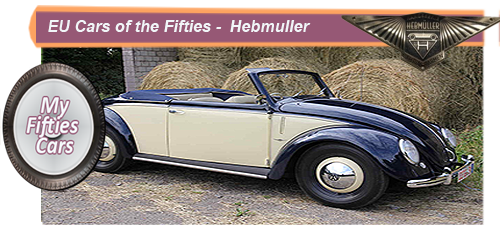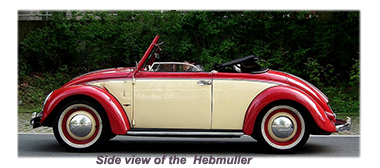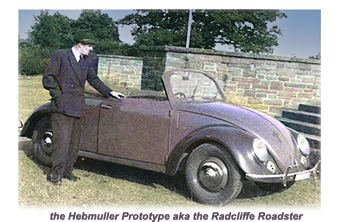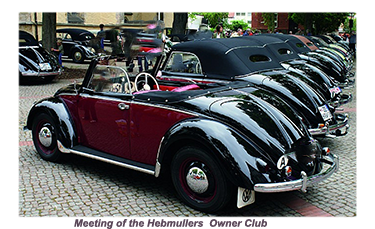
With most of West Germany in ruins, a department of British Occupation Force headed by the legendary Major Ivan Hurst, was handed the difficult task of pulling Volkswagen out of the rubble and usher them back into production.
Hirst handled the resurrection himself, while delegating responsibility to the two other plants, Karmann and Hebmüller to two of his subordinates.
P laced in charge at Hebmüller was Colonel Charles Radclyffe, like Hurst a trained engineer.
Hirst overall production strategy for the three companies, was that Volkswagen would produce the TI saloon, Karmann would produce a four door cabriolet and Hebmüller a two door roadster
Founded towards the end of the Nineteenth Century by Joseph Hebmüller ,Hebmüller and Sons specialised in the production of carriage bodies.
laced in charge at Hebmüller was Colonel Charles Radclyffe, like Hurst a trained engineer.
Hirst overall production strategy for the three companies, was that Volkswagen would produce the TI saloon, Karmann would produce a four door cabriolet and Hebmüller a two door roadster
Founded towards the end of the Nineteenth Century by Joseph Hebmüller ,Hebmüller and Sons specialised in the production of carriage bodies.
 At the end of the First World War, Hebmüller’s four sons took over the running of the company, expanding it dramatically during the Twenties and Thirties producing coupes and convertible bodies for some of Europe’s leading car manufacturers, among them Delahaye and Hanomag.
During World War Two , the Nazi government took control off the Hebmüller plant, taking advantage of the company’s traditional coachbuilding skills to produce engineless airplanes to be used as decoys.
At the end of the First World War, Hebmüller’s four sons took over the running of the company, expanding it dramatically during the Twenties and Thirties producing coupes and convertible bodies for some of Europe’s leading car manufacturers, among them Delahaye and Hanomag.
During World War Two , the Nazi government took control off the Hebmüller plant, taking advantage of the company’s traditional coachbuilding skills to produce engineless airplanes to be used as decoys.
 With Germany in ruins after the war, the British administration were handed the administrative responsibilities for Volkswagen and, as part of the package, coachbuilders Karmann and Hebmüller.
It was decided that Karmann would be awarded the rights to manufacture a four-seater cabriolet version of the Beetle, while Hebmüller, whose production capacity was much smaller, to build a two-seater compact roadster version based on a design which became known as the 'Radclyffe Roadster'.
With Germany in ruins after the war, the British administration were handed the administrative responsibilities for Volkswagen and, as part of the package, coachbuilders Karmann and Hebmüller.
It was decided that Karmann would be awarded the rights to manufacture a four-seater cabriolet version of the Beetle, while Hebmüller, whose production capacity was much smaller, to build a two-seater compact roadster version based on a design which became known as the 'Radclyffe Roadster'.
 The Radclyffe title derived from the custom-built prototype commissioned by the British Army from coachbuilder Rudolph Ringel.
The Ringel prototype was rapidly requisitioned by Colonel Charles Radclyffe, a key figure in the British Army’s Occupation Force, involved in the reconstruction of the West German Car Industry.
Sitting on the same frame as the Beetle and powered by the same air-cooled 25 hp (19 kW) 995 cc (60.7 cu in)Volkswagen engine, the T14, as it was now titled was a bit of an “ugly duckling” with the rear engine cover as long as the boot cover in the front.
The Radclyffe title derived from the custom-built prototype commissioned by the British Army from coachbuilder Rudolph Ringel.
The Ringel prototype was rapidly requisitioned by Colonel Charles Radclyffe, a key figure in the British Army’s Occupation Force, involved in the reconstruction of the West German Car Industry.
Sitting on the same frame as the Beetle and powered by the same air-cooled 25 hp (19 kW) 995 cc (60.7 cu in)Volkswagen engine, the T14, as it was now titled was a bit of an “ugly duckling” with the rear engine cover as long as the boot cover in the front.
 There were just two seats, with little attempt to provide seating for rear seat passengers.
The Hebmüller was fitted with some quirky accessories typical of the times, such as turn signal semaphores placed in the side cowl area adjacent to the front bumper , and a removable Telefunken Radio.
To add to its homely feel, a flower vase made from exquisite German porcelain was attached to the dashboard.
Production for the Type 14A, , had barely gotten underway in the late Forties, when a fire caused serious damage to the Hebmüller factory.
Although production was rapidly resumed, it transpired that the company were insufficiently insured leaving them with considerable debt that they could not finance.
Under the burden of these debts, Hebmüller soldiered on for little more than a year before they were forced to file for bankruptcy. During that time the company succeeded in producing 696 type 14As
There were just two seats, with little attempt to provide seating for rear seat passengers.
The Hebmüller was fitted with some quirky accessories typical of the times, such as turn signal semaphores placed in the side cowl area adjacent to the front bumper , and a removable Telefunken Radio.
To add to its homely feel, a flower vase made from exquisite German porcelain was attached to the dashboard.
Production for the Type 14A, , had barely gotten underway in the late Forties, when a fire caused serious damage to the Hebmüller factory.
Although production was rapidly resumed, it transpired that the company were insufficiently insured leaving them with considerable debt that they could not finance.
Under the burden of these debts, Hebmüller soldiered on for little more than a year before they were forced to file for bankruptcy. During that time the company succeeded in producing 696 type 14As
<> Because of their remarkably short production run, with less than seven hundred produced, the Hebmüller Type 14A has become a major collector’s item, especially since less than a hundred still remain in circulation.
Because of their remarkably short production run, with less than seven hundred produced, the Hebmüller Type 14A has become a major collector’s item, especially since less than a hundred still remain in circulation.
That’s the reason for such excitement when not one but two of these extremely rare and almost extinct “beetles” have recently resurfaced.
The first , a fully restored version of the Hebmuller, reared its head at an auction held in Monterey, California in 2016. Although there were plenty of bidders, the car failed to make its reserve of $300,000 although the final bid was reportedly really close
 Recently classic car lovers had an opportunity to really get the know the Hebmüller Type 14A when one the recipient of total restoration at the world renowned Kindig-it Design shop based in Salt Lake City, US.
Recently classic car lovers had an opportunity to really get the know the Hebmüller Type 14A when one the recipient of total restoration at the world renowned Kindig-it Design shop based in Salt Lake City, US.
Dave Kindig and his super talented crew were commissioned to totally reconstruct a T14A, making major developments in its technology while retaining its original appearance and integrity.
Take me back to the home page.

